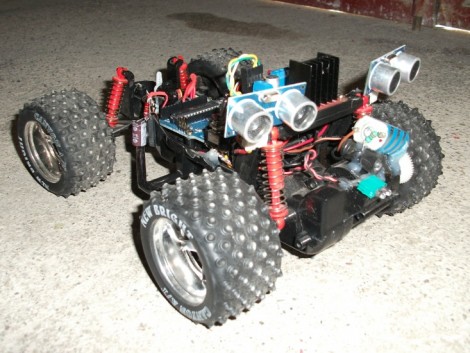
[Eduard Ros] wrote in show off his first attempt at building an autonomous rover (translated). As with many of these projects, he started with the base of a remote control toy truck. This solves so many mechanical issues, like steering, locomotion, and power source.
He just needed a way to control the vehicle. The recent LayerOne badge hacks either did this through the wireless controller protocol or by adding an Arduino directly to the vehicle. [Eduard] chose the latter, and also included obstacle avoidance sensors in the process. We’ve seen quite a few that use these ultrasonic rangefinders. He decided to go a different route by adding two of them rather than scanning by mounting one on a servo motor.
The video after the break shows the vehicle successfully navigating through a tight space. This makes us wonder how much data can be processed from the stationary sensors? We’re not familiar with how wide the horizontal sensitivity is on the devices. If you have some insight, please share you knowledge in the comments section.
















I find it interresting that he decided to run it in reverses (as a rear-steering setup). I can see how it would make the programming easier since the camera is AT the pivot, but I don’t think it would have occured to me to try that.
It had never occurred to me either, but hey it’s better than those stupid 90 degree turn robots that never get anywhere. The only disadvantage to backing up is that you don’t know what’s behind the robot until you do. Maybe he should put sensors in the back too. :-)
typically no great,
https://docs.isy.liu.se/twiki/pub/VanHeden/DataSheets/srf04.pdf
I just used one of these exact sensors in a project and I’ve found that they’ll reliably give range for anything in about a 20 degree cone up to 2.5 meters.
Ultrasonic range sensors can have varying fields of view. Some are around 15deg and some can be nearly 90deg.
Multiple sensors mounted at different angles is superior to scanning for fast robots. One of the major issues with scanning is you can only look one direction at a time. If your robot is fast, it can easily run into something in the time it takes to take a couple readings in the wrong direction, especially with ultrasonic sensors that can take 40ms to get a measurement. You can’t just speed up the scan speed due to the field of view of the sensors, and this is true even with Sharp IR rangers (I found this out in a competition unfortunately).
The small field of view (>5deg for Sharp IR rangers such as GP2D12) isn’t nearly as much of a problem as you might expect. I normally use three sensors, one facing directly forward, and two to the sides, between 10 and 45 degrees out. Because you are moving, the sensors read a large area.
Hey nice work I was wondering when the robot detects a obstacle if I wanted it to turn right/left how can I do it. Is it same thing as the reverse thing what all changes should I make. Reply as soon as possible any help would be appreciated.